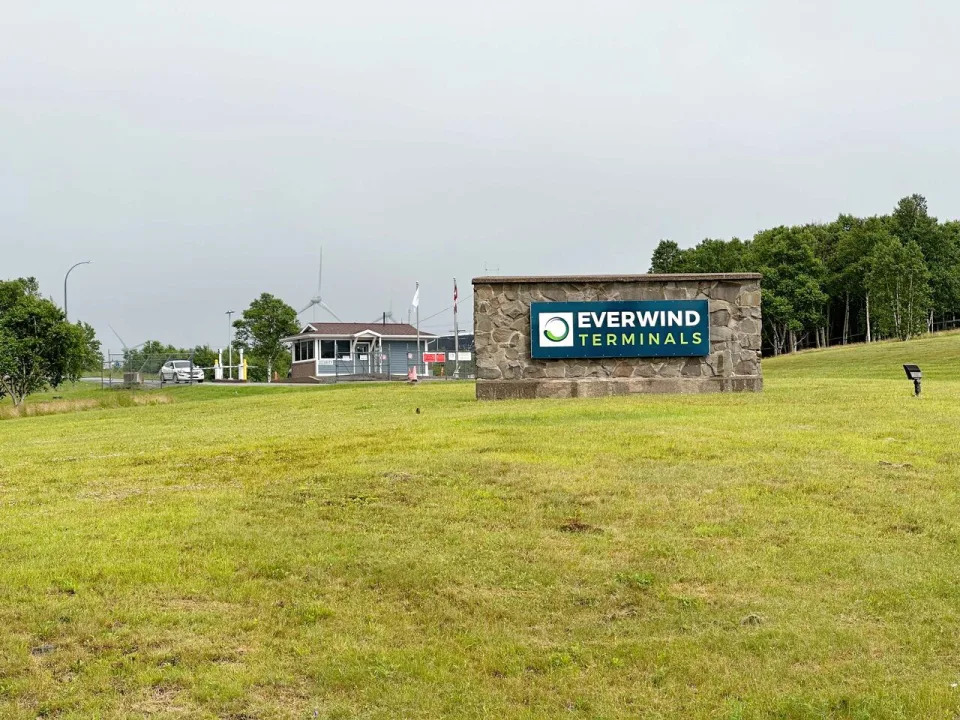NOVA SCOTIA
Residents concerned that most energy from Colchester County wind farm will be for exportCBC
Fri, February 16, 2024

EverWind Fuels in Point Tupper, N.S., is getting a $125-million loan from the federal government to help the company build a proposed green hydrogen production plant.
(Tom Ayers/CBC - image credit)
The company behind a proposed 50-turbine wind farm in Colchester County is preparing to submit for an environmental assessment, but residents have concerns about where the energy will end up.
Nancy Frame moved to Folly Mountain, N.S., about 40 kilometres northeast of Truro, to be closer to nature. She has concerns about how the proposed Windy Ridge Wind Farm could affect the Cobequid Mountains — where other wind farms are being planned.
"Not only are we sacrificing this landscape, but we don't even have the satisfaction of knowing it's going to go into our own grid," said Frame.
EverWind is planning three farms, in partnership with wind power company RES and First Nations communities, to power a green hydrogen and ammonia facility in Point Tupper, N.S.
The province has approved 17 turbines at another project in Colchester and 15 at a farm that borders the municipalities of West Hants, Chester and Halifax.
However, only excess power generated by the farms will be sold to Nova Scotia Power. The main purpose of the wind farms will be to provide power to produce ammonia and hydrogen for export.
"We think that likely 20 per cent of the energy from the project will likely be used domestically,' said Brendan Chard, EverWind's vice-president of power.
The company behind a proposed 50-turbine wind farm in Colchester County is preparing to submit for an environmental assessment, but residents have concerns about where the energy will end up.
Nancy Frame moved to Folly Mountain, N.S., about 40 kilometres northeast of Truro, to be closer to nature. She has concerns about how the proposed Windy Ridge Wind Farm could affect the Cobequid Mountains — where other wind farms are being planned.
"Not only are we sacrificing this landscape, but we don't even have the satisfaction of knowing it's going to go into our own grid," said Frame.
EverWind is planning three farms, in partnership with wind power company RES and First Nations communities, to power a green hydrogen and ammonia facility in Point Tupper, N.S.
The province has approved 17 turbines at another project in Colchester and 15 at a farm that borders the municipalities of West Hants, Chester and Halifax.
However, only excess power generated by the farms will be sold to Nova Scotia Power. The main purpose of the wind farms will be to provide power to produce ammonia and hydrogen for export.
"We think that likely 20 per cent of the energy from the project will likely be used domestically,' said Brendan Chard, EverWind's vice-president of power.

Over 80 people attended a presentation held by EverWind to update the community on Feb. 12, an open house was also held the following day.
(Luke Ettinger/CBC)
Nova Scotia Power will have an agreement with the Point Tupper plant that it can divert wind energy to the grid if necessary.
Still, that's not enough to convince Madeline Conacher with Sustainable Northern Nova Scotia. She said the province should be focused on getting off coal before exporting wind energy.
From January to September 2023, coal and petroleum coke made up almost a third of energy used in the province, according to Nova Scotia Power. Meanwhile, wind made up 13 per cent.
"It's what Canada does, we give away our natural resources first, and anything left over we get," said Conacher. "And that's not good enough anymore. We want to support local investment in turbines."
Frame said seeing turbines on the horizon would be easier to accept if the energy was staying in Nova Scotia, but she is also concerned about the size of the Windy Ridge farm.

Nancy Frame, who lives in Folly Mountain, N.S. has concerns about how a proposed wind farm could affect the Wentworth Valley area — particularly because the energy is producing green hydrogen and ammonia for export.
(Luke Ettinger/CBC)
"We're increasingly putting [biodiversity and ecosystems] at risk if we're going to develop a sector that so much of our landscape has to be devastated," said Frame.
At one point over 100 turbines were proposed by EverWind throughout the province, but the number has been reduced.
Andrea Cosman, a development manager with RES, said the company has also adapted the location of turbines to address resident concerns about proximity to watersheds, old-growth forests and recreational areas.
"We understand it is a big change that comes into a community and we do want to listen," Cosman said at an open house.
For the Colchester projects, EverWind is also promising an annual $100,000 community-vibrancy fund in addition to offering bursaries for post-secondary education.
The turbines must be more than two kilometres from residences, in accordance with a municipal bylaw. EverWind is also promising about $1,000 per year to the 278 residences within three kilometres of Colchester projects.
"Colchester County has some of the strictest setback requirements and noise-threshold requirements that I've ever encountered across the country" said Cosman. "It might be the first of this magnitude in Nova Scotia, but Quebec has seen turbine projects that are much bigger."
No comments:
Post a Comment